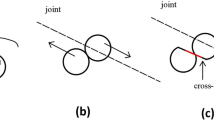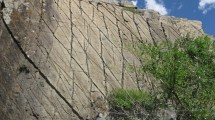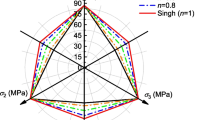Abstract
Two new three-dimensional rock mass strength criteria are developed in this paper by extending an existing rock mass strength criterion. These criteria incorporate the effects of the intermediate principal stress, minimum principal stress and the anisotropy resulting from these stresses acting on the fracture system. In addition, these criteria have the capability of capturing the anisotropic and scale dependent behavior of the jointed rock mass strength by incorporating the effect of fracture geometry through the fracture tensor components. The new criteria are proposed after analyzing 284 numerical modeling results of the polyaxial, triaxial and biaxial compression tests conducted on the jointed rock blocks having one or two joint sets by the PFC3D software. Some of these simulation results were compared with experimental results to validate the developed PFC3D model that was used for numerical modeling of jointed blocks. In this research to have several samples with the same properties a synthetic rock material that is made out of a mixture of gypsum, sand and water was used. Altogether, 12 joint systems were chosen; some of them had one joint set and the rest had two joint sets. Joint sets have different dip angles varying from 15° to 45° at an interval of 15° with dip directions of 30° and 75° for the two joint sets. Each joint set also has three persistent joints with the joint spacing of 42 mm in a cubic sample of size 160 mm. The minimum and intermediate principal stress combination values were chosen based on the uniaxial compressive strength (UCS) value of the modeled intact synthetic rock. The minimum principal stress values were chosen as 0, 0.2, 0.4 and 0.6 of the UCS. For each minimum principal stress value, the intermediate principal stress value varies starting at the minimum principal stress value and increasing at an interval of 0.2 of the UCS until it is slightly lower than the strength of the sample under the biaxial loading condition with the same minimum principal stress value. To express the new rock mass strength criteria, it was also necessary to determine the intact rock strengths under the same confining stress combinations mentioned earlier. Therefore, the intact rock was also modeled for all three compression tests and the intact rock strengths were found for 33 different minimum and intermediate principal stress combinations.




















Similar content being viewed by others
Abbreviations
- A :
-
Disk area
- \(a\), \({a_2}\), \({a_3}\), \(b\), \({b_2}\), \({b_3}\) :
-
Empirical coefficients
- B :
-
An empirical constant
- \({B^J}\) :
-
Constant coefficient of the modified smooth-joint contact model
- \({C_J}\) :
-
Joint cohesion
- D min, D max :
-
Minimum and maximum particle diameters
- \({E_{\text{c}}}\), \({\bar {E}_{\text{c}}}\) :
-
Contact and bond Young’s modulus of the linear parallel bond model, respectively
- \({F_{ij}}\), \(F_{{ij}}^{r}\), \(F_{{ij}}^{k}\) :
-
Fracture tensor, fracture tensor of the rock mass and fracture tensor of the kth joint set, respectively
- \({F_{11}}\), \({F_{22}}\), \({F_{33}}\) :
-
Fracture tensor components in the maximum, intermediate and minimum principal stress directions, respectively
- \(f\), \({f_2}\), \({f_3}\) :
-
Monotonically decreasing functions
- \(K_{n}^{J}\), \(K_{s}^{J}\) :
-
Joint normal and shear stiffnesses, respectively
- \(k_{n}^{J}\), \(k_{s}^{J}\) :
-
Joint normal and shear stiffnesses of the modified smooth-joint contact model, respectively
- \(k_{{{n_{{\text{min}}}}}}^{J}\) :
-
Minimum joint normal stiffness of the modified smooth-joint contact model
- k r ,\({\bar {k}_r}\) :
-
Ratio of the normal to shear stiffnesses of the contact and bond for the linear parallel bond model, respectively
- m :
-
Number of parameters to be estimated
- \({m^{\left( V \right)}}\) :
-
Number of fracture centers
- N :
-
Total number of joint sets
- n :
-
Total number of data sets
- n :
-
Normal vector
- \({n_i}\), \({n_j}\) :
-
Projection of the normal vector in the directions of i and j, respectively
- p, \(~{p_2}\), \({p_3}\), q, \({q_2}\), \({q_3}\) :
-
Empirical coefficients
- \({R^2}\) :
-
Coefficient of determination
- r :
-
Equivalent radius
- \({S_r}\) :
-
Strength ratio between the jointed rock mass and intact rock strengths
- V :
-
Assumed volume
- X, Y, Z :
-
Cartesian coordinates
- \(\lambda\), \({\lambda _0}\), \({\lambda _2}\), \({\lambda _3}\) :
-
Empirical coefficients
- \(\bar {\lambda }\) :
-
Bond radius fraction of the Linear Parallel Bond Model
- \(\mu\) :
-
Friction coefficient of the Linear Parallel Bond Model
- \(\mu^{J}\) :
-
Joint friction coefficient of the Modified Smooth-Joint Contact model
- \({\sigma _1}\), \(~{\sigma _2}\), \(~{\sigma _3}\) :
-
Maximum, Intermediate and Minimum principal stresses, respectively
- \({\sigma _c}\) :
-
Uniaxial compressive strength
- \({\bar {\sigma }_c}\), \({\bar {\tau }_s}\) :
-
Bond tensile and shear strengths of the Linear Parallel Bond Model, respectively
- \({\sigma _J}\), \({\sigma _I}\) :
-
Jointed rock mass and intact rock strengths, respectively
- \(\sigma _{{J,i}}^{P}\) :
-
Predicted jointed rock block strength from the new rock mass strength criterion for data set i
- \(\sigma _{{J,i}}^{{{\text{PFC}}}}\) :
-
Strength of the jointed rock block from the PFC3D modeling for data set i
- \(\overline{\sigma } _{{J,i}}^{{{\text{PFC}}}}\) :
-
Average strength value of all the PFC3D data
- \({\sigma _n}\) :
-
Normal stress
- \(\sigma _{n}^{J}\) :
-
Normal stress on the Modified Smooth-Joint Contact
- \({\varphi _J}\) :
-
Joint friction angle
- CUMTB:
-
China University of Mining and Technology, Beijing
- DEM:
-
Discrete element method
- JSC:
-
Joint sides checking approach
- LPBM:
-
Linear parallel bond model
- LVDT:
-
Linear variable differential transformer
- MSJCM:
-
Modified smooth-joint contact model
- NIOSH:
-
National Institute for Occupational Safety and Health
- PFC:
-
Particle flow code
- PFC3D :
-
Three-dimensional particle flow code
- SJCM:
-
Smooth-joint contact model
- UCS:
-
Uniaxial compressive strength
- 3DEC:
-
Three-dimensional distinct element code
References
Amadei B (1996) Importance of anisotropy when estimating and measuring in situ stresses in rock. Int J Rock Mech Min Sci 33(3):293–325. https://doi.org/10.1016/0148-9062(95)00062-3
Bahaaddini M, Sharrock G, Hebblewhite BK (2013) Numerical direct shear tests to model the shear behaviour of rock joints. Comput Geotech 51:101–115. https://doi.org/10.1016/j.compgeo.2013.02.003
Bahaaddini M, Hagan PC, Mitra R, Hebblewhite BK (2015) Parametric study of smooth joint parameters on the shear behaviour of rock joints. Rock Mech Rock Eng 48(3):923–940. https://doi.org/10.1007/s00603-014-0641-6
Bandis SC, Lumsden AC, Barton NR (1983) Fundamentals of rock joint deformation. Int J Rock Mech Min Sci Geomech 20(6):249–268. https://doi.org/10.1016/0148-9062(83)90595-8
Barton N, Lien R, Lunde J (1974) Engineering classification of rock masses for the design of tunnel support. Rock Mech Rock Eng 6(4):189–236. https://doi.org/10.1007/BF01239496
Bekaert A, Maghous S (1996) Three-dimensional yield strength properties of jointed rock mass as a homogenized medium. Mech Cohes-Frict Mat 1(1):1–24. https://doi.org/10.1002/(SICI)1099-1484(199601)1:1%3C1::AID-CFM1%3E3.0.CO;2-O
Bieniawski ZT (1973) Engineering classification of jointed rock masses. Trans S Afr Inst Civ Eng 15:335–344
Chiu CC, Wang TT, Weng MC, Huang TH (2013) Modeling the anisotropic behavior of jointed rock mass using a modified smooth-joint model. Int J Rock Mech Min Sci 62:14–22. https://doi.org/10.1016/j.ijrmms.2013.03.011
Cho NA, Martin CD, Sego DC (2007) A clumped particle model for rock. Int J Rock Mech Min Sci 44(7):997–1010. https://doi.org/10.1016/j.ijrmms.2007.02.002
Colak K, Unlu T (2004) Effect of transverse anisotropy on the Hoek–Brown strength parameter ‘mi’for intact rocks. Int J Rock Mech Min 41(6):1045–1052. https://doi.org/10.1016/j.ijrmms.2004.04.004
Cundall PA, Hart RD (1992) Numerical modelling of discontinua. Eng computations 9(2):101–113. https://doi.org/10.1108/eb023851
Cundall PA, Strack OD (1979) A discrete numerical model for granular assemblies. Geotechnique 29(1):47–65
Duan K, Kwok CY (2016) Evolution of stress-induced borehole breakout in inherently anisotropic rock: Insights from discrete element modeling. J Geophys Res Solid Earth 121(4):2361–2381. https://doi.org/10.1002/2015JB012676
Fakhimi A (2004) Application of slightly overlapped circular particles assembly in numerical simulation of rocks with high friction angles. Eng Geol 74(1):129–138. https://doi.org/10.1016/j.enggeo.2004.03.006
Fan X, Kulatilake PHSW, Chen X (2015) Mechanical behavior of rock-like jointed blocks with multi-non-persistent joints under uniaxial loading: a particle mechanics approach. Eng Geol 190:17–32. https://doi.org/10.1016/j.enggeo.2015.02.008
Gigli G, Casagli N (2011) Semi-automatic extraction of rock mass structural data from high resolution LIDAR point clouds. Int J Rock Mech Min Sci 48(2):187–198. https://doi.org/10.1016/j.ijrmms.2010.11.009
Goodman RE (1976) Methods of geological engineering in discontinuous rocks. West Information Publishing Group
He PF, Kulatilake PHSW, Liu DQ, He MC (2016) Development of a new three-dimensional coal mass strength criterion. Int J Geomech 17(3):04016067. https://doi.org/10.1061/(ASCE)GM.1943-5622.0000741
Hoek E (1994) Strength of rock and rock masses. ISRM News J 2(2):4–16
Ismael MA, Imam HF, El-Shayeb Y (2014) A simplified approach to directly consider intact rock anisotropy in Hoek–Brown failure criterion. J Rock Mech Geot Eng 6(5):486–492. https://doi.org/10.1016/j.jrmge.2014.06.003
Itasca Consulting Group Inc (2016) PFC manual, version 5.0, Minneapolis
Koyama T, Jing L (2007) Effects of model scale and particle size on micro-mechanical properties and failure processes of rocks—a particle mechanics approach. Eng Anal Bound Elem 31(5):458–472. https://doi.org/10.1016/j.enganabound.2006.11.009
Kulatilake PHSW (1985) Estimating elastic constants and strength of discontinuous rock. J Geotech Eng ASCE 111(7):847–864. https://doi.org/10.1061/(ASCE)0733-9410(1985)111:7(847)
Kulatilake PHSW (2016) Physical, empirical and numerical modeling of jointed rock mass strength. In: Feng XT, Hudson J (eds) Rock Mechanics and Engineering, CRC Press, Balkema (invited book chapter)
Kulatilake PHSW, Shu B (2015) Prediction of rock mass deformations in three dimensions for a part of an open pit mine and comparison with field deformation monitoring data. Geotech Geol Eng 33:1551–1568. https://doi.org/10.1007/s10706-015-9921-5
Kulatilake PHSW, Wang S, Stephansson O (1993) Effect of finite size joints on deformability of jointed rock at the three dimensional level. Int J Rock Mech Min Sci 30(5):479–501. https://doi.org/10.1016/0148-9062(93)92216-D
Kulatilake PHSW, Malama B, Wang J (2001) Physical and particle flow modeling of jointed rock block behavior under uniaxial loading. Int J Rock Mech Min 38(5):641–657. https://doi.org/10.1016/S1365-1609(01)00025-9
Kulatilake PHSW, Park J, Malama B (2006) A new rock mass failure criterion for biaxial loading conditions. Geotech Geol Eng 24(4):871–888. https://doi.org/10.1007/s10706-005-7465-9
Kulatilake PHSW, Shreedharan S, Sherizadeh T, Shu B, Xing Y, He P (2016) Laboratory estimation of rock joint stiffness and frictional parameters. Geotech Geol Eng 34(6):1723–1735. https://doi.org/10.1007/s10706-016-9984-y
Lee H, Jeon S (2011) An experimental and numerical study of fracture coalescence in pre-cracked specimens under uniaxial compression. Int J Solids Struct 48:979–999. https://doi.org/10.1016/j.ijsolstr.2010.12.001
Malama B, Kulatilake PHSW (2003) Models for normal fracture deformation under compressive loading. Int J Rock Mech Min Sci 40(6):893–901. https://doi.org/10.1016/S1365-1609(03)00071-6
Marinos V, Marinos P, Hoek E (2005) The geological strength index: applications and limitations. Bull Eng Geol Environ 64(1):55–65. https://doi.org/10.1007/s10064-004-0270-5
Mas Ivars D, Pierce ME, Darcel C, Reyes-Montes J, Potyondy DO, Young RP, Cundall PA (2011) The synthetic rock mass approach for jointed rock mass modelling. Int J Rock Mech Min Sci 48(2):219–244. https://doi.org/10.1016/j.ijrmms.2010.11.014
Mehranpour MH, Kulatilake PHSW (2016) Comparison of six major intact rock failure criteria using a particle flow approach under true-triaxial stress condition. Geomech Geophy Geo-energ Geo-Resour 2(4):203–229. https://doi.org/10.1007/s40948-016-0030-6
Mehranpour MH, Kulatilake PHSW (2017) Improvements for the smooth joint contact model of the particle flow code and its applications. Comput Geotech 87:163–177. https://doi.org/10.1016/j.compgeo.2017.02.012
Melkoumian N, Priest SD, Hunt SP (2009) Further development of the three-dimensional Hoek–Brown yield criterion. Rock Mech Rock Eng 42(6):835–847. https://doi.org/10.1007/s00603-008-0022-0
Oda M (1982) Fabric tensor for discontinuous geological materials. Soils Found 22(4):96–108. https://doi.org/10.3208/sandf1972.22.4_96
Oda M (1984) Similarity rule of crack geometry in statistically homogeneous rock masses. Mech Mater 3(2):119–129. https://doi.org/10.1016/0167-6636(84)90003-6
Pan XD, Hudson JA (1988) A simplified three dimensional Hoek–Brown yield criterion. In: ISRM International symposium. International Society for Rock Mechanics
Park JW, Song JJ (2009) Numerical simulation of a direct shear test on a rock joint using a bonded-particle model. Int J Rock Mech Min Sci 46(8):1315–1328. https://doi.org/10.1016/j.ijrmms.2009.03.007
Pierce M, Cundall P, Potyondy D, Mas Ivars D (2007) A synthetic rock mass model for jointed rock. In: Eberhardt E, Stead D, Morrison T (eds) Rock Mechanics: Meeting Society’s Challenges and Demands. Proceeding of the 1st Canada–US rock mechanics symposium; May 27–31 Vancouver, Canada. London: Taylor & Francis Group, 1:341–349
Potyondy DO (2015) The bonded-particle model as a tool for rock mechanics research and application: current trends and future directions. Geosyst Eng 18(1):1–28. https://doi.org/10.1080/12269328.2014.998346
Potyondy DO, Cundall PA (2004) A bonded-particle model for rock. Int J Rock Mech Min Sci 41(8):1329–1364. https://doi.org/10.1016/j.ijrmms.2004.09.011
Pouya A, Ghoreychi M (2001) Determination of rock mass strength properties by homogenization. Int J Numer Anal Met 25(13):1285–1303. https://doi.org/10.1002/nag.176
Priest SD (2005) Determination of shear strength and three-dimensional yield strength for the Hoek–Brown criterion. Rock Mech Rock Eng 38(4):299–327. https://doi.org/10.1007/s00603-005-0056-5
Ramamurthy T (2001) Shear strength response of some geological materials in triaxial compression. Int J Rock Mech Min 38(5):683–697. https://doi.org/10.1016/S1365-1609(01)00035-1
Saroglou H, Tsiambaos G (2008) A modified Hoek–Brown failure criterion for anisotropic intact rock Int J Rock Mech Min 45(2):223–234. https://doi.org/10.1016/j.ijrmms.2007.05.004
Schöpfer MP, Childs C, Manzocchi T (2013) Three-dimensional failure envelopes and the brittle-ductile transition. J Geophys Res-Sol Ea 118(4):1378–1392. https://doi.org/10.1002/jgrb.50081
Shehata WM (1972) fundamental considerations on the hydraulic characteristics of joints in rock. In: Proceedings of the symposium on percolation through fissured rock, Sep 18–19; Stuttgart, Germany. paper (No. T1-F)
Sheorey PR, Biswas A, Choubey VD (1989) An empirical failure criterion for rocks and jointed rock masses. Eng Geol 26(2):141–159. https://doi.org/10.1016/0013-7952(89)90003-3
Shreedharan S, Kulatilake PHSW (2016) Discontinuum–equivalent continuum analysis of the stability of tunnels in a deep coal mine using the distinct element method. Rock Mech Rock Eng 49(5):1903–1922. https://doi.org/10.1007/s00603-015-0885-9
Singh B, Goel RK (2011) Engineering rock mass classification: tunnelling, foundations and landslides. Butterworth-Heinemann (an imprint of Elsevier), Massachusetts
Swan G (1983) Determination of stiffness and other joint properties from roughness measurements. Rock Mech Rock Eng 16(1):19–38. https://doi.org/10.1007/BF01030216
Wu Q, Kulatilake PHSW (2012) REV and its properties on fracture system and mechanical properties, and an orthotropic constitutive model for a jointed rock mass in a dam site in China. Comput Geotech 43:124–142. https://doi.org/10.1016/j.compgeo.2012.02.010
Yang X, Kulatilake PHSW, Jing H, Yang S (2015) Numerical simulation of a jointed rock block mechanical behavior adjacent to an underground excavation and comparison with physical model test results. Tunn Undergr Sp Tech 50:129–142. https://doi.org/10.1016/j.tust.2015.07.006
Yu Q (2001) Computational simulations of shear behavior of joints in brittle geomaterials. Doctoral dissertation, McGill University, Montreal
Yudhbir Y, Lemanza W, Prinzl F (1983) An empirical failure criterion for rock masses. In 5th ISRM Congress. International Society for Rock Mechanics
Zhang L (2008) A generalized three-dimensional Hoek–Brown strength criterion. Rock Mech Rock Eng 41(6):893–915. https://doi.org/10.1007/s00603-008-0169-8
Zhang L, Zhu H (2007) Three-dimensional Hoek-Brown strength criterion for rocks. J Geotech Geoenviron 133(9):1128–1135. https://doi.org/10.1061/(ASCE)1090-0241(2007)133:9(1128)
Zhang Q, Zhu H, Zhang L (2013) Modification of a generalized three-dimensional Hoek–Brown strength criterion. Int J Rock Mech Min 59:80–96. https://doi.org/10.1016/j.ijrmms.2012.12.009
Zhang Y, Stead D, Elmo D (2015) Characterization of strength and damage of hard rock pillars using a synthetic rock mass method. Comput Geotech 65:56–72. https://doi.org/10.1016/j.compgeo.2014.12.002
Zheng J, Kulatilake PHSW, Shu B, Sherizadeh T, Deng J (2014) Probabilistic block theory analysis for a rock slope at an open pit mine in USA. Comput Geotech 61:254–265. https://doi.org/10.1016/j.compgeo.2014.06.002
Acknowledgements
The research was funded by the National Institute for Occupational Safety, and Health (NIOSH) of the Centers for Disease Control, and Prevention (Contract No. 200-2011-39886).
Author information
Authors and Affiliations
Corresponding author
Additional information
Publisher’s Note
Springer Nature remains neutral with regard to jurisdictional claims in published maps and institutional affiliations.
Rights and permissions
About this article
Cite this article
Mehranpour, M.H., Kulatilake, P.H.S.W., Xingen, M. et al. Development of New Three-Dimensional Rock Mass Strength Criteria. Rock Mech Rock Eng 51, 3537–3561 (2018). https://doi.org/10.1007/s00603-018-1538-6
Received:
Accepted:
Published:
Issue Date:
DOI: https://doi.org/10.1007/s00603-018-1538-6




